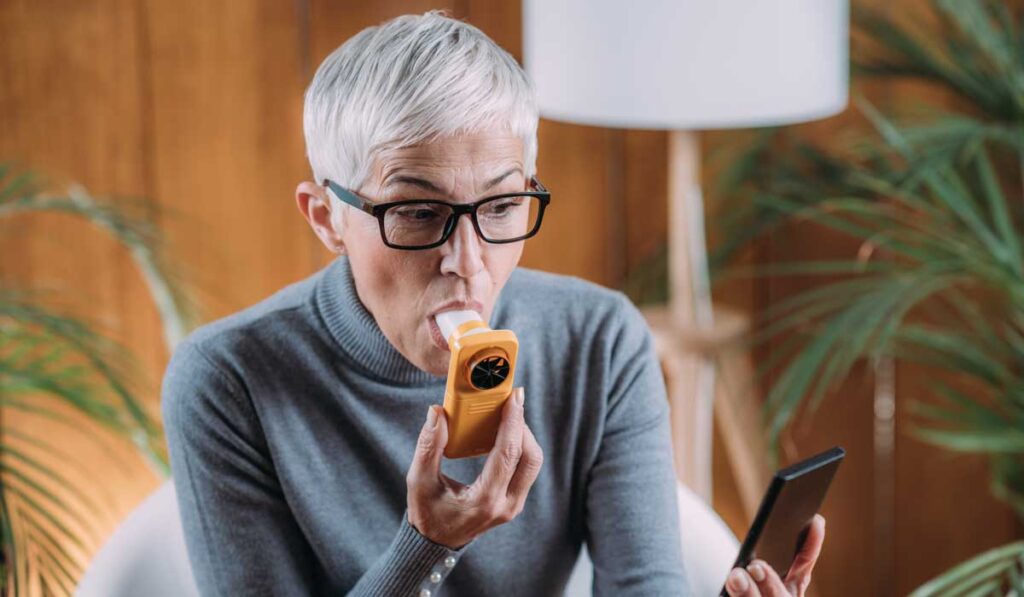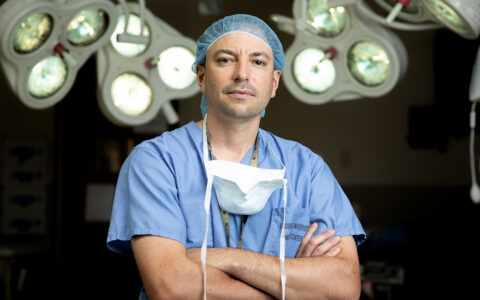An inexpensive device to monitor peak expiratory flow (PEF) can be a game changer in postoperative follow-up for patients with idiopathic subglottic stenosis (iSGS). Patients who use these meters with a smartphone to track their recovery are now able to easily communicate with their doctors without leaving home. This leads to more consistent tracking and a quicker response time to what can be a quickly deteriorating scenario.
These findings derive from a five-year, multi-institutional study of 810 patients with iSGS led by Alexander Gelbard, M.D., an associate professor of otolaryngology and co-director of the Complex Airway Reconstruction Program (AeroVU) at Vanderbilt University Medical Center.
New research from Gelbard and colleagues, published in Laryngoscope, further examines data from PEF home use. “Coupling physiologic monitoring performed remotely with an engaged patient network and powerful smartphones is really transforming how we can help our patients before relapse,” Gelbard said.
Monitoring a Confounding Disease
A unique disease that arises just below the vocal cords, iSGS causes luminal obstruction of the upper airway. Affecting roughly one in 400,000 people, the rare disease occurs almost exclusively in adult, Caucasian women, striking in middle age. Treatment is primarily procedural, but because of high recurrence rates, the majority of iSGS patients will require multiple surgeries following their initial diagnosis.
Past analyses by the North American Airway Collaborative (NoACC) found correlations between peak flow rates obtained during formal pulmonary function testing and changes in airway caliber resulting from airway stenosis. NoAAC investigators demonstrated that smaller extrathoracic airways were associated with lower peak expiratory flow rates. This finding validated PEF as a sensitive and specific predictor for disease recurrence in airway stenosis.
“Coupling physiologic monitoring performed remotely with an engaged patient network and powerful smartphones is really transforming how we can help our patients before relapse.”
“While we showed that PEF obtained in a specialized pulmonary function lab was a valid means of monitoring airway caliber in iSGS, in an effort to make our care more patient centered, we investigated patient self-monitoring with PEF recorded on a smartphone at home,” Gelbard said.
Predictive Data Emerges
The new study looked at patient-generated health data and PEF to characterize respiratory physiology in iSGS disease progression. In total, 385 patients with appropriate PEF measurements completed the three-year study, with each undergoing standard-of-care treatment at their respective hospitals.
“This study focused on the iSGS patient population, but has ramifications for patients who develop subglottic scarring after intubation,” Gelbard said. “Subglottic scarring has become a larger problem with the massive increase in intubations during the COVID-19 pandemic.”
“This finding tells us that there are patient-specific biological variables that impact disease recurrence, rather than the specifics of the procedures themselves.”
The analysis revealed that patients with a significant decline in PEF (30 percent or higher over 90 days) had a much higher probability of disease recurrence. Surprisingly, however, there was no association between the magnitude of postoperative PEF improvement and the risk of recurrent operative procedure. “This was counterintuitive and has led us to hypothesize that the location of the airway stenosis may be as important as the degree of blockage at causing symptoms,” Gelbard said.
“No matter how well the procedure improves airflow, it doesn’t necessarily translate to a lower recurrence rate,” he added. “This finding tells us that there are patient-specific biological variables that impact disease recurrence, rather than the specifics of the procedures themselves.”
Dissemination and New Research
“We’re really excited about the uptake of these findings across our community of ENT surgeons,” Gelbard said. “This project was a large collaborative effort, involving more than 30 institutions internationally. These groups have a vested stake and a deep understanding of the results, and as a result, have begun to incorporate home PEF monitoring into their clinical practices.”
With additional funding from the NIH, Gelbard and colleagues are now probing the response of the immune system at the site of airway scarring within the lining of the upper respiratory tract. “We want to understand why these problems in the airway develop, what makes them better or worse, and why they recur after treatment,” he said.





